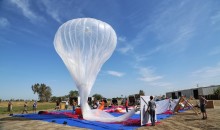Google’s Project Loon To Deliver Internet Everywhere
Google has developed some impressive projects over the years, from the most used search engine on the internet, to futurisitc eyewear.
The next Google project is all about balloons!
For the past few months, Raven Aerostar has been working closely with Google in a pilot project called Project Loon, designed to provide broadband wireless internet access to millions of people worldwide.
This innovative solution being tested in New Zealand is a network of Raven Aerostar High Altitude Balloons, each 15 meters in diameter, deployed into the stratosphere 20 km above earth which provide internet access to places currently without the world wide web.
“Raven Aerostar is our balloon design partner and manufacturer of our envelopes. They bring to the project decades of expertise in high altitude balloon engineering as well as the latest breakthroughs in supper pressure balloon engineering.”
– Mike Cassidy, Project Lead, Google[X]
This collaboration has the potential to change millions of lives. Improved medical care, access to knowledge, and enriched agriculture are all benefits of connecting people.
PROJECT LOON QUICK FACTS
- Google and Raven Aerostar
- Bringing internet connectivity to developing nations
- 60 feet in diameter SUPER PRESSURE BALLOONS; pumpkin shaped
- Multiple week flight duration
- Approximately 67,000 feet cruising altitude
- Stratollite technology
- Solar panels provide system power
RAVEN AEROSTAR QUICK FACTS
- Raven Industries founded 1956
- Publicly traded (NASDAQ:RAVN)
- Red Bull Stratos balloon manufacturer
- Solves great challenges through innovative technologies
- RAVEN AEROSTAR BALLOON RECORD: Longest duration with a large scientific payload (55 days, 1 hour and 34 minutes aloft)
- Raven Aerostar balloon record: Heaviest scientific payload (8,000 pounds)
- Raven Aerostar balloon record: Largest balloon ever successfully flown (60 million cubic feet)
As Mike Cassidy, Google’s Project Lead, wrote in his blog:
Over time, we’d like to set up pilots in countries at the same latitude as New Zealand. We also want to find partners for the next phase of our project—we can’t wait to hear feedback and ideas from people who’ve been working for far longer than we have on this enormous problem of providing Internet access to rural and remote areas. We imagine someday you’ll be able to use your cell phone with your existing service provider to connect to the balloons and get connectivity where there is none today.
This is still highly experimental technology. Google and their partners have a long way to go. You can keep up to date with the latest news of the project here on balloonteam.net plus you can follow directly on the project’s Google+ page.




